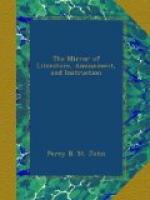[1] The circular part.
The late perfect restoration of the Temple Church ought to be proudly recorded in our architectural annals. The excellence of the workmanship, and the native purity of the detail, evince not only scientific skill, but also a laudable motive of preserving this antique specimen of pure Anglo-Norman architecture from the ravages of time. Let the architect’s attention be directed to the western doorway, and also to the interior of the church; and here, in good preservation, he will see excellent specimens of their mode of ornamenting the moldings by the cable, the lozenge, the cheveron, the nail-head, the billet, &c. &c., ornaments peculiar to the round style. The circular-headed windows, with their slender columns, also show, that in the restoration the style has not been tampered with; but substantial authorities have been quoted to perfect this praiseworthy attempt of the architect. That part of the church which has been added at a later date than the circular part, and for the convenience of divine worship, is lighted by the beautiful proportioned triple lancet-shaped windows, so justly admired. A writer in the Gentleman’s Magazine for May, 1827, after making some judicious remarks, seems to think the crosses on the ends of the building, “as not in character with the building.” Now as to architectural propriety in the decorations of a Christian church, no ornament could be better devised; and if we proceed to the antiquity of such ornament, I would observe, that the adoption would be equally correct, that being the insignia of the banner under which the Knights’ Templars originally fought.
C. Davy.
* * * * *
BRIDGET TROT AND TIMOTHY GREEN.
(For the Mirror.)
“’Tis a common
tale,
An ordinary sorrow of man’s
life;
A tale of silent sufferings,
hardly clothed
In bodily form.”
Wordsworth.
Miss Bridget Trot, a “wo"-man
was,
Of excellent repute,
Who kept a stand in Leadenhall,
And there disposed of fruit.
And though in features rather dark,
No fairer could be
found;
For what she sold, like ringing
gold,
When peeled, was always
sound!
She had moreover notions high,
And thought herself above
The very low-ly common way
Of falling into love.
And therefore when to her his suit
A Snip did often press
With vows of love, she cut him
short
At length, without
re-dress.
Yet nothing odd was there in this
One case, it must be said;
For who that wish’d a perfect
man
Could with a ninth part
wed?
Not she for one, whatever he
Might do to make him smart,
And howsoe’er her saying “Nay”
Might add it to his heart.




